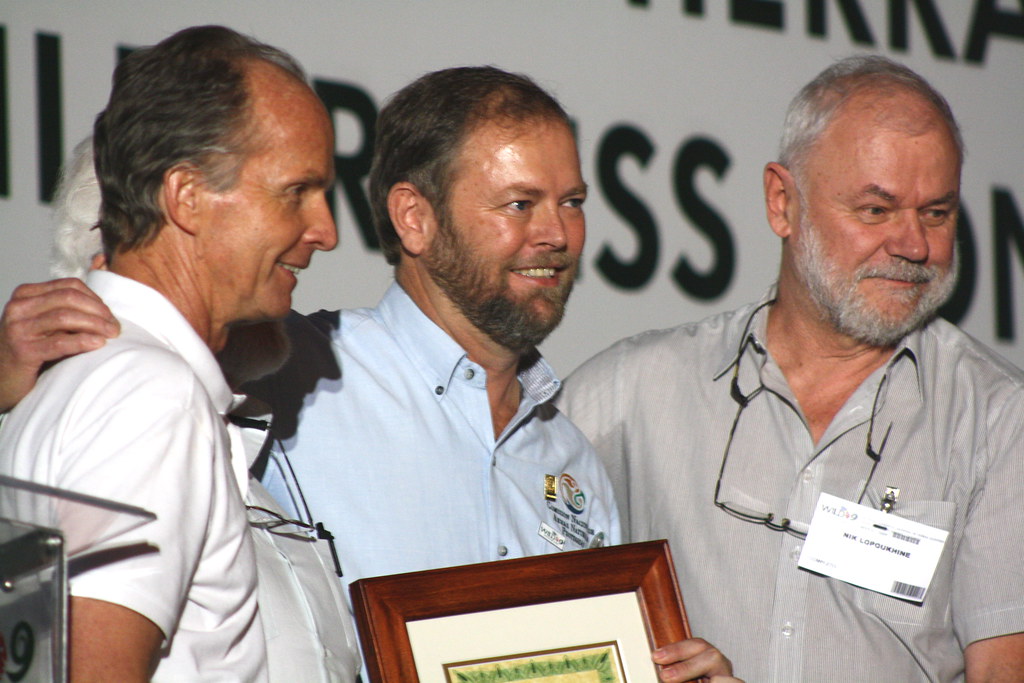Greg Harman
Since the 1930s, there's been talk of a Mexican counterpart to the 800,000-acre wilderness of Big Bend National Park being established south of the Rio Grande.
But with little history or experience with federal wild lands management, it has taken Mexico's largest cement company and some influential non-profits to begin cobbling together private lands across the river for wilderness conservation. More recently, the federal government has followed by designating some areas as protected areas, but they mostly remain in private hands.

However, early next year Ernesto Enkerlin Hoeflich, head of the nation's National Commission on Protected Areas (middle right, receiving the 2009 Kenton R. Miller Award for Innovation in Protected Area Sustainability last week), expects the Mexican government to announce the first “umbrella agreement” on the creation of a true bi-national park system with the U.S.
It seems the country, in the midst of gangland warfare between and within the various drug cartels, army, and police forces, is also experiencing what Hoeflich calls a “small golden age for conservation.”
“Right now in Mexico, we're living in a time of very positive things happening for conservation,” said Enkerlin.
But don't strap on your hiking boots just yet. Since a dramatic show of force by the U.S. Border Patrol in 2002, a late-coming response to the 9/11 attacks in the badlands of Big Bend, the long-used area crossings have been closed. They'll likely remain that way even as ecological connections and international agreements are signed.
Referring to the reopening of those crossings â?? an issue Big Bend National Park's spokesperson says remains in the hands of U.S. Homeland Security â?? Enkerlin said:
“That's, of course, something that's going to happen eventually, we hope, but it's not something that we should worry too much about right now. Because if we focus on that we might not get the other part, which in a way is more important.”
He added that reestablishing human relationships across the river in this region would be “beneficial” to both countries in terms of overall national relations but also for security in the communities of la frontera.
“There was a continuous presence `before 2002` and that made for a good environment, safety wise,” he said. “So we're hoping to recuperate that good environment. We understand why it needed to be stopped, but we think there are good possibilities.”
Ultimately, Enkerin said his department is hoping to see 300,000 hectares, or 730,000 acres, given wilderness protection.
But don't expect a “peace” park from the ongoing bi-national discussion, as the partnership was originally envisioned.
Mexican officials are more interested in simply calling it a “bi-national park” or a “park of concorida â?¦ something that reflects more the culture, the Mexican culture,” Enkerlin said. “We believe a peace park is something that is not understood quite the same way by the Mexican people.”
David Elkowitz, Big Bend Naitonal Park's spokesperson, tried to drain some of the air out of the bi-national park balloon, saying: “There is hope, but that does not necessarily mean it'll be realized. There are hoops to jump through.” Adding that, “We might know more in a couple of months.”
Still, interest is high on both sides of the river for the project and the potential for the creation of trans-boundary eco-tourism throughout the region, something that would benefit communities across the states of Coahuila, Chihuahua, and Texas.
While Mexican cement company CEMEX currently owns 300,000 acres of the Sierra del Carmen, the Mexican government has so far only set aside 42,500 acres as wilderness. Still, that designation is a first for all of Latin America, Enkerlin says. And there's room to grow still.
“There's potential to get to 200,000 or maybe 300,000 hectares of wilderness in the region, which is what we're shooting for,” Enkerlin said. “I mean, 23,000 hectares is nice, but it's not enough for wilderness.”
And so, the first protected wild space, or tierra silvestres, in all of Latin America could grow to more than 730,000 acres in the near future, a worthy companion for our own Big Bend.
Dr. Ernesto Enkerlin Hoeflich, a parrot expert and, we should note, a Texas Aggie, was awarded the 2009 Kenton R. Miller Award for Innovation in Protected Area Sustainability at last week's World Wilderness Congress in Mérida, Mexcio. A report on that congress will appear soon in the San Antonio Current.

















